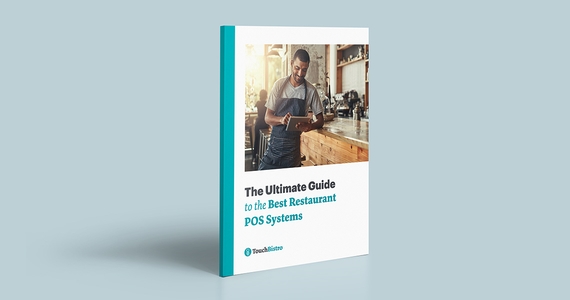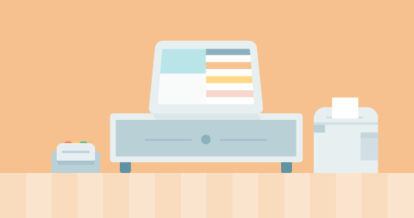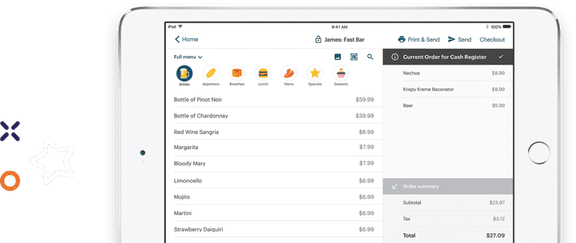When buying a new system, POS or otherwise, before putting down a lot of money, you naturally come armed with questions that help ensure you’re putting your cash in the right place.
This same questioning should be applied when looking for a new restaurant POS system, whether you’re shopping for your first POS system or looking to switch your provider. There are multiple options on the market, so arming yourself with the right questions to ask about a POS system will help you talk to sales teams and end up with a product that meets all your business needs.
But… what do you need to ask during sales discussions?
We’ll go over the top 14 things to consider before you buy a restaurant POS system – and before you sign any dotted lines. These 14 questions will also help you know what to look for in a POS system. Below, you can find the questions broken down by key categories: hardware, system capabilities, integrations, and contracts, and costs.

Learn more about the different restaurant management solutions TouchBistro has to offer in this complete product guide.
Hardware
POS hardware is a huge thing to consider when deciding on a new restaurant POS – after all, it’s the equipment that houses your POS software. There are a couple of questions you’ll want to check off related to hardware when shopping the POS market.
1. What type of hardware does the point of sale system use?
Chances are, this will come up naturally in your discussions with POS providers. This is important to know, especially with how passionate people get about #TeamApple, #TeamAndroid, or other proprietary hardware built specifically for the software – which can get very expensive.
For example, if you know you and your team are most comfortable on Apple devices, you might find it difficult to work with a POS that can’t run on Apple. If you want a specific hardware brand, this can help narrow down your search early on.
2. What hardware is required to run the system?
You know when you buy a new exciting piece of technology and get all excited to open it, only to find out the batteries weren’t included? Or part of it comes separately? Frustrating, right?
You don’t want to pick a restaurant POS and find out you didn’t account for all the hardware required. Ask early on exactly what is needed – it’s likely more than one iPad or tablet. Some hardware requirements you’ll want to make sure to ask about include:
- Number of iPads or tablets for your restaurant size
- Printers
- Wiring
- Internet router
- Payment devices
- POS keyboards (if you have any desktop devices)
When you ask about all the POS hardware requirements, you avoid unpleasant surprises down the road.

Systems and Capabilities
Different system capabilities are important things to consider before you buy a restaurant POS system. A restaurant POS can do so much for your venue. While many systems have the same basic capabilities – such as processing sales and sending orders to the kitchen – you still want to ask about each system’s capabilities.
Here are the most important areas to cover when considering different systems and their capabilities.
3. What are the system’s basic capabilities?
This may seem like a general question, but it’s a helpful starting point to get to know the system. This is where different POS providers can let you know general features – such as changing your menu or sending orders to the kitchen.
This question can also potentially knock off some of your other questions early on by helping you find out what the system can’t do or doesn’t do as well as another solution.
For example, maybe the system can’t handle online ordering well, and if a large portion of your sales come from online ordering, this would be a deal-breaker for you. By finding this out early, you’ll save time and be able to spend time considering and choosing the right system for you.
4. Is there any downtime with my POS?
What happens if your Internet crashes? Can you take payments offline? With some systems, losing your Internet connection can be the start of a shift straight out of a horror movie.
With many cloud-based POS systems, no Internet can mean no features (cue scream). This is why asking about offline capabilities is key. Some of the major features you risk losing with a completely cloud-based systems include:
- Processing payments and gift cards
- Staff clocking in or out from shifts
- Sending orders from the floor to the kitchen
- No access to reports
Things go wrong. The Internet cuts out. But your whole service shouldn’t be ruined by it.

Compare the top restaurant POS systems on features, pricing, payments, and more.
5. Can my POS help with labor?
The answer here should be, yes! Your restaurant POS should help with scheduling and labor insights, such as top-performing staff and labor hours.
Consider this: You’re trying to plan your holiday staff. You don’t want to overschedule, but you also don’t want to schedule too few people. As the holidays roll around, most days you’re either short-staffed or have extra servers waiting around. Either way, it’s less than ideal.
With your labor reports on your POS, you don’t have to make the same mistake twice. Use your past labor data to forecast staffing requirements more accurately, saving you headaches and money on labor hours.
6. Can I get real-time insights and reporting?
Your restaurant POS is packed full of valuable information, and your reports organize that information for you. The information you pull from these reports should give you valuable insights for running your restaurant and making more informed decisions, with insights in real-time!
Because reports can be such a powerful tool, you’ll want to ask about the reporting your system has. Some information you’ll want to see in your reports includes:
- Discounts and voids – How much are you spending on these? What staff members are making the most voids?
- Menu insights – Sort your menu by category, quantity sold, percentage of daily sales each menu item contributed, or others
- Payment details – What methods of payment are people using? When did transactions take place?
While you’re asking about the reports available, you’ll also want to ask how you manage these reports. Do you have to go into the building every time you want to pull a report?
Ask about cloud reporting capabilities. With this remote access, you can pull and manage reports from anywhere – whether it be in between off-site meetings or from bed for a (well-deserved) day sleeping in. Your reports don’t have to be limited to your physical restaurant space.
Integrations Needs
Many restaurant POS systems do more than just process and track sales, thanks to some powerful integrations. These integrations build out your system functionality while putting valuable hours back into your busy week.
Below are some integrations you’ll want to ask about for your business’ POS.
7. What are your top or most used integrations?
Consider this answer a free recommendation from restaurant owners already using the restaurant POS software you’re considering. This will give you some insight into what people in the industry are finding valuable, expose you to new integrations you didn’t know were available, give you a sense of what’s available for your current needs, and what you’ll have access to as your business grows.

Learn more about the different restaurant management solutions TouchBistro has to offer in this complete product guide.
8. What is available to help manage inventory?
Inventory management is one of the most important parts of running a restaurant. According to TouchBistro’s 2025 State of Restaurants Report, 26% of operators identified food/inventory costs having caused them the greatest financial strain this past year.
A lot of restaurant POS systems will have some powerful inventory capabilities and integrations to help minimize that struggle. Since inventory is such a large issue for veterans and new restaurant owners alike, it’s crucial to ask about any integrations to make this process smoother.

9. Can my restaurant POS software link to my accounting software?
You mean, you don’t want to spend hours going back and forth manually inputting your POS data into accounting software?
With a point of sale that integrates directly into accounting software, you can avoid the tedious manual entry – and inevitable errors that come along with that. Finding out what accounting integrations are available can save you many headaches – and accounting errors – in the long run.
10. What are your options for payment processing?
While you are running a restaurant to serve delicious food and make people happy, you’re also trying to make money. So how are you processing payments at your restaurant?
Payment processing isn’t something you can skip at your restaurant, unless you choose to go completely card-free and accept cash only. Whether you’re looking for an integrated processor or a standalone system, most restaurant POS systems will have different payment processing options available. Try to steer clear of POS providers that only offer one option for payment processing. Without the freedom to choose, you won’t be able to find the one that actually fits your business needs nor switch when/if those needs change.

Compare the top restaurant POS systems on features, pricing, payments, and more.
Contracts and Costs
We’ve saved the best for last – cost and contracts are critical things to consider before you buy a restaurant POS system. And there are more questions you’ll want to ask on this topic beyond the total cost of the system.
Here are the top questions to ask about a POS system when choosing the right one for you.
11. How much does this POS cost?
This will likely be one of your first questions, but make sure you ask before you sign anything! This includes the cost of hardware and software (which can be either a one-time fee or a monthly/yearly subscription fee).
You’ll also have to keep in mind that some integrations are an additional cost on top of the POS. We talked before about the different integrations you can ask about, but figure out how much those can cost on top of your software and hardware costs.
12. What are your pricing models?
You know the cost, but how are you paying it? Is it a monthly subscription? A yearly payment? And what are the different pricing models, based on your restaurant size? There’s no one-price-fits-all solution on the market for restaurant POS systems, so while your buddy down the street paid one price to accommodate his venue, you might pay another.
Getting the information on pricing models will show you what you’re going to pay for your specific needs.
13. Am I locking myself into a contract?
You think your two-year cellphone contract is brutal? Try a four-year contract with a restaurant POS you end up not being happy with.
If you find a provider you love, it makes sense to stick with them – even for four years! But you don’t want to be trapped.
If you end up agreeing to a long-term contract, you’ll also want to confirm there’s some type of guarantee if you’re unhappy from the get-go. Some providers charge tens of thousands of dollars to get out of your contract, even if it’s within the first 30 days
14. How transparent are your payment processing rates? Are there hidden fees? Can you up my rates at any time?
While this seems like a lot of questions, they all tackle one area of contracts and costs – your payment processing rates. Having as much clarity as possible on these rates is important before you sign anything. You don’t want to find any surprises on your bill months into your contract.
The right restaurant POS provider will be able to give you straightforward answers.
Also, make sure they aren’t able to change the rates on you. Imagine signing onto one rate, and finding it raised a few months later, and you have no ground to stand on. You may feel you’re getting a good deal on your processing rate at the beginning, but in a few months or a year, the unexpected higher prices will have you thinking otherwise.
And believe it or not, that’s pretty common practice with some restaurant point of sale systems.
Bringing a new partner into your restaurant isn’t a one-step process. There are screenings, numerous questions, and some back and forth – until you finally find somebody that you know you can work with.
Think of a new restaurant POS system as bringing on a new business partner. Take the time you need to ask all these questions and more if they come up. You want to bring in systems and partners you can trust, not one you’ll end up regretting.






